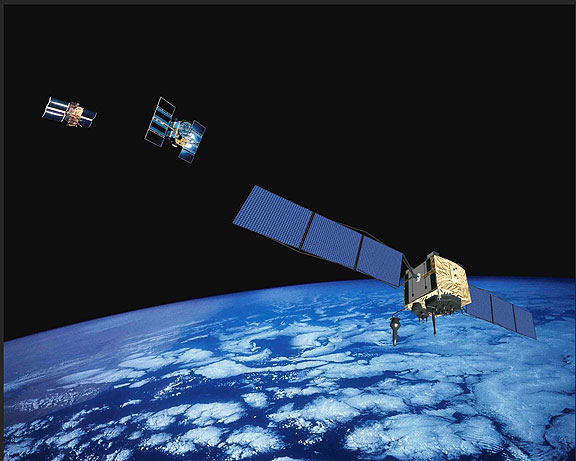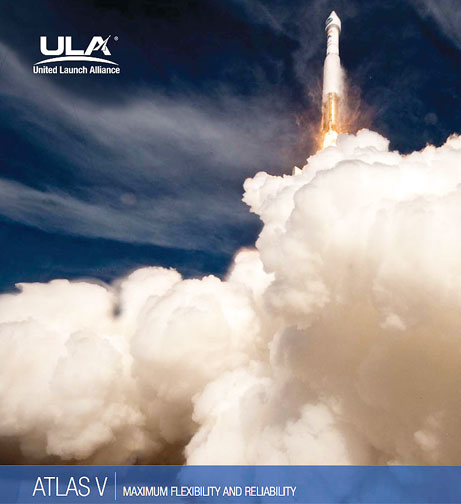
Today, the vehicle Launch Readiness Review was completed and everything is proceeding for the Air Force’s Global Positioning System (GPS) IIF-4 launch. The mission is set to liftoff on a ULA Atlas V on Wednesday, May 15 from Space Launch Complex 41 at Cape Canaveral Air Force Station in Florida.
The 18-minute launch window opens at 5:38 p.m. EDT. Today’s L-2 forecast continues to show an 80 percent chance of favorable weather conditions for launch.
Overall probability of violating weather constraints: 20% Primary concern(s): Cumulus Clouds
Overall probability of violating weather constraints for 24 hour delay: 30% Primary concern(s): Cumulus Clouds, Thick Clouds
GPS is a space-based, world-wide navigation system providing users with highly accurate, three-dimensional position, velocity and timing information 24 hours a day in all weather conditions. Boeing has been the prime contractor for four GPS satellite programs since 1974 and is now under contract to the Air Force to build 12 next-generation GPS Block IIF satellites. The GPS IIF-4 built by Boeing for their client the U.S. Air Force.
Tuesday, May 14
- 10:00 a.m.: Atlas V rolls to the pad
Wednesday, May 15
5:18 p.m.: The GPS IIF-4 launch will be carried live beginning 20 minutes prior to launch and will conclude approximately 20 minutes following launch. A simulcast of the broadcast can be viewed here.
5:38 p.m.: Opening of the launch window
Satellite Coordinates (all time eastern) BARS AND TONE – 4:48 P.M. EDT PROGRAM START – 5:18 P.M. EDT
Created by the U.S. Department of Defense to enhance US military warfighting capability, GPS is available for use, free of charge, to anyone with a GPS receiver. U.S. and allied military forces use GPS devices in virtually every system to improve their capabilities and effectiveness while reducing risk to their forces and non-combatants. From finance to farming to tracking packages, use by the civilian community continues to grow rapidly and new commercial applications are continuously being developed.

This increased civil and commercial use of GPS, coupled with lessons learned from years of military operations and specific experiences during Operation Desert Storm, Kosovo, Desert Shield and Iraqi Freedom, drove a desire to modernize the system and augment its capabilities while sustaining the current GPS mission. In response to new civil demands and the emerging doctrines of navigation warfare, the Air Force was charged with directing and procuring improvements to the GPS constellation. Boeing was selected to support the Air Force in architecting the future of GPS, guiding the introduction of new capabilities and technologies into the Block IIF to create a modernized satellite.
The GPS IIF system brings next-generation performance to the constellation. The GPS IIF vehicle is critical to U.S. national security and sustaining GPS constellation availability for global civil, commercial and defense applications. Besides sustaining the GPS constellation, IIF features more capability and improved mission performance.
Each GPS IIF satellite delivers:
—Greater navigational accuracy through improvements in atomic clock technology —A new civilian L5 signal to aid commercial aviation and search and rescue operations —Improved military signal and variable power for better resistance to jamming in hostile environments —A 12-year design life providing long-term service and reduced operating costs —Receive software uploads for improved system operation
The first GPS IIF satellite was launched on May 27, 2010 and entered service on August 26, 2010. The second satellite, which launched on July 16, 2011, entered service on August 22, 2011. The third satellite launched on October 4, 2012. Boeing's innovative pulse-line manufacturing approach will deliver the IIF fleet on schedule. Similar to an airplane assembly line, the IIF pulse line efficiently moves a satellite from one work area to the next in a steady rhythm, like a pulse.
In 2007, Boeing successfully assisted the Air Force in seamlessly deploying two new major ground control segment elements: Launch and Early Orbit, Anomaly Resolution, and Disposal Operations (LADO) and the Architecture Evolution Plan (AEP) Operational Control System (OCS). These systems have enhanced the performance of the current on-orbit GPS fleet while preparing to also operate the new GPS IIF satellites.
GPS IIF is the product of Boeing's long legacy with the GPS, dating back to the beginning of the very first GPS program in 1974. As the prime contractor on the GPS Block I, Block II, and Block IIA and Block IIF programs, Boeing has built 40 of the 62 GPS satellites launched since 1978.
Boeing has worked closely with the Air Force for nearly 40 years to help ensure excellent service to the nearly one billion military and civilian users around the world.

